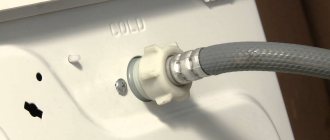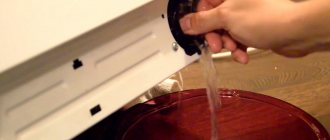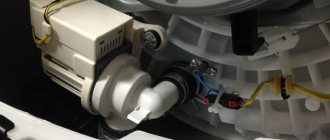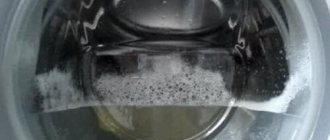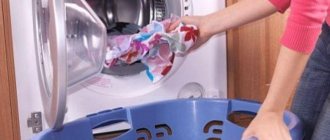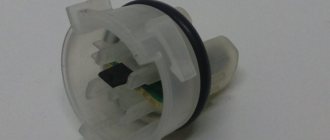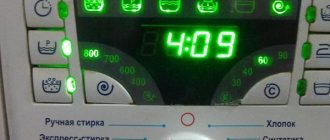Published: 15 Dec 2020
The washing machine has finished washing. You hung up your things, opened the hatch wider to let the tank dry, pulled out the detergent tray, but it was full of powder. It turns out that the laundry was washed in slightly soapy water and was unlikely to wash properly. You understand that you will have to wash it again, but first you need to figure out why the powder remained in the washing machine tray.
How does the process of collecting powder and conditioner work?
To understand this, you need to find out the principle of this process for washing devices. All washing machines, as a rule, are equipped with special trays where detergent in the form of powder or gel, conditioner, fragrances, etc. are placed. Automatic washing machines have pull-out trays, inside of which there are 3-4 compartments designed for different stages of washing. During the washing process, water is supplied inside the tray, washing away powders, gels, and conditioners directly into the washing tank with laundry. Why doesn't the washing machine always pick up the powder from the compartment?
Design features of trays
Trays in any washing machine have two main designs:
- with multiple intake valves;
- with one inlet valve.
Trays with one inlet valve are usually equipped with mechanically controlled washing machines. This is a rather complex system for moving water from one section of the tray to another. Modern electronically controlled washing devices have trays with multiple inlet valves separately for each compartment.
What to do if the powder is not washed away
If you are convinced that there is normal pressure in the pipes, but the product is not washed off after washing, you need to check other parts.
Check the filling system
Turn off the water supply. Substituting the container, unscrew the intake hose from the SMA body. Inspect it for blockages. There is a mesh filter behind the hose. Remove it with pliers and rinse under running water to remove any blockage.
Next you need to check the fill valve:
- Remove the top cover from the case. To do this, unscrew the two screws at the back.
- There is an intake valve at the back wall.
- Disconnect the hoses leading to it and check for blockages.
- Then you need to ring the coil using a multimeter.
- If the problem is not a blockage, but a malfunction of the coils, then the valve must be completely replaced.
- To do this, disconnect the wiring from it.
- Remove the screws that hold the valve to the back of the body.
- Pull out the old one and install the new part.
If after reinstallation the powder is not washed out again and does not go away, inspect the nozzles and pipes through which the detergent flows from the tray to the tank. They can also be cleaned under running water.
The washing machine does not pick up powder from the compartment, reasons and solutions
If the powder remains in the tray during washing, there may be many reasons for this, for example:
- poor quality powder;
- its quantity is incorrect;
- incorrect choice of program mode for washing;
- weak water pressure;
- Malfunction of the water flow switching valve.
You can find out why the washing machine does not pick up powder from the tray by following a series of steps to check the device. There are several ways to determine the cause of what happened and eliminate it.
What to check first
First try closing and then opening the main cold water tap.
Check the water pressure by opening the tap in the bathroom, for example. Also, if the apartment uses old water pipes, the protective mesh on the tap may be clogged with various debris and pieces of rust that do not allow water to pass through them. Attention. Low water pressure can occur when simultaneously using water from other taps (kitchen, bathroom, toilet). First of all, we exclude factors related to the detergent itself, its quality, quantity, and dosage. Next you need to check:
- the flow of water into the machine (is the water supply valve open, is there sufficient water pressure);
- correct choice of compartment for washing powder in the tray;
- the channel for water entering the compartment with powder (may be clogged);
- the correct amount of powder used (it is better to use a measuring spoon).
- Is the water supply valve fully open (if it is not open all the way, water can fill into the tank of the machine very slowly and for a long time);
- if the tray is littered with powder that has not washed off, stuck together in a lump or dried out from the previous wash, you should remove the tray and rinse thoroughly with warm water;
- whether the required amount of powder has been added correctly.
Advice. It is best to use good quality washing powders for washing, and it is advisable to rinse the tray itself after each wash.
It's all about the powder
The quality of washing powder is of great importance. If the powder is of poor quality or counterfeit, it may form lumps and dissolve poorly. If you poured more of it than necessary, it may also remain in the compartment or become lumpy. The required amount of laundry detergent is usually indicated on the detergent label and is calculated based on the amount of dirty laundry placed in the washing machine.
Water supply problems
The reasons for not washing off the powder with water from the tray may also be:
- Low water pressure. If the pressure is weak, the water will not be able to rinse the powder out of the compartment well. It will remain on the walls, accumulate, and clog the water supply channel.
- Check whether the water supply valve to the washing machine is fully open.
- If the pressure is good, then you can also check the fill valve filter, which often becomes clogged due to poor quality water inside the water pipes.
Check if the water supply valve is fully open.
The filter mesh is clogged
A clogged strainer located in front of the water inlet valve is often the cause of unused powder remaining inside the tray after washing. To clean it you need:
- disconnect the washing machine from the power supply;
- turn off the water supply tap;
- remove by unscrewing the inlet hose attached to the rear side of the machine body;
- Use pliers to carefully pull out the filter;
- rinse it thoroughly and replace it;
- screw on the hose.
Water inlet valve faulty
During the normal washing process, the valve opens and the required amount of water is drawn into the machine. But if the valve is faulty or broken, then water may flow in small quantities or not at all. In this case, the machine gives a signal about the lack of water. This is why the washing machine leaves powder inside the tray. This problem can only be solved by replacing the valve. Important. In modern electronically controlled washing machines, as a rule, several special solenoid valves are installed that supply water to different compartments of the tray. If the powder remains in the tray, you need to remove the top cover and figure out why the valve does not supply water to the desired compartment.
Clogged pipes
The washing machine does not take all the powder from the tray if the drain pipe of the washing solution into the machine tank is clogged.
This can be determined by the remaining water in the powder compartment or because water may be leaking out of the tray. In addition to the pipes, the hoses themselves, which connect the water supply valves to the powder receptacles, can sometimes become clogged. To clean the pipes you need to open the top panel, which is secured with two bolts to the rear wall. For this:
- unscrew the bolts and move the panel back a little;
- there are 2 hoses, one supplies water to the compartment with the powder, through the second the water is drained into the drum;
- remove the hoses by loosening the clamps that secure them;
- clean them from the inside, check for integrity;
- insert the hoses into place, securing them well;
- run an empty test wash.
The powder receptacle itself is clogged
The cuvette, in which the tray itself with compartments for powder and other detergents is located, also needs to be washed periodically to avoid clogging.
This is done like this:
- open the cuvette all the way;
- by pressing the lid with your finger in the place of the special pointer or by pulling the tray with the compartments towards you and slightly downwards, remove it;
- clean, wash;
- clean all sides of the cuvette where the tray is inserted, check whether the water supply holes are clogged;
- return the tray to its place, returning it to the cuvette until it stops.
The laundry loading door is not closed
The reason why the powder is not washed off in a household washing machine may be a door that does not close hermetically due to a broken locking tab on it, or a latch in the housing lock. In this case, water will not be supplied and washing will not start. This often happens due to the skew of the hinges on the door or the stem falling out of the tongue that serves as a fastener for it.
Broken water inlet valve
This element is responsible for the timely supply of water inside the machine. When a signal is received that there is already enough water in the washing tank, the valve shuts off the water. If the valve is broken, it will not open and will not be able to supply water.
To understand what’s wrong with it, it’s best to ring it, since such breakdowns usually occur due to a burnt-out coil. The valve is located behind the washing device; the inlet hose fits just right into it. If the valve fails, it simply needs to be replaced.
Broken software module
This “computer” device of the washing machine controls all the intelligent actions of the machine; all washing programs, data, and functionality for controlling all sensors are concentrated here. If the cause of the malfunction lies in this software module, then you cannot do without service specialists.
The cause of the malfunction may be powder
- You need to make sure that the powder is poured into the correct compartment. It is important to review the instructions for the equipment. It often happens that users put the powder in the pre-wash compartment, and not in the main wash. If the pre-wash program is not turned on, then naturally the powder remains untouched.
- Poor quality powder. Often cheap powders turn into clumps and stick to the sides of the tray. After each wash it must be washed, but the quality of washing deteriorates significantly. It is recommended to approach the choice of washing powder responsibly, since the operation of the equipment and the cleanliness of the laundry depend on it.
- Amount of powder added. If there are a lot of detergents, then it will not be completely washed out of the tray. Experts recommend carefully studying the instructions for use and using measuring spoons. Such measures will help save your budget and improve the quality of your laundry.
This is interesting: Do-it-yourself blender repair: detailed instructions with photos
In what cases is it necessary to contact a specialist?
Everything regarding external causes of malfunctions associated with the remaining powder in the tray, such as problems with the powder, mesh filter, clogged pipes, can be eliminated independently.
But everything that relates to malfunctions of the water supply system, software module or replacement of inlet valves is best entrusted to specialists who carry out repairs, following the manufacturer’s flow charts, using original spare parts.
Watch a video about why the washing machine does not wash away powder well
Why does detergent remain in the washing machine tray after finishing the wash: solving the problem
If the detergent has not completely dissolved and there is residue left in the container, you should:
- Initially, make sure that the water pressure is sufficient for full operation of the equipment, and that the inlet valve is fully open. Low pressure can occur due to the simultaneous use of water in other rooms (kitchen, toilet, bathroom).
- Check the quality of the powder by dissolving a little in a bowl (if there is any insoluble residue). Check the amount of detergent loaded into the tray by reading the instructions for the household appliance.
- Determine whether the compartment for pouring powder is selected correctly.
The cause of the problem may be debris clogged in the filter mesh.
To clean it, you need:
- Close the inlet valve and turn off the power to the washing machine.
- Disconnect the hose from the housing.
- Using tweezers and pliers, remove the filter mesh.
- Wash and, if necessary, soak in vinegar or citric acid.
- Install the system in place.
In addition, you must:
- Check the operation of the intake valve; if it is damaged, replace it with a new one.
- Inspect the pipes and hoses supplying water to the container with the detergent composition. If clogged, remove them, rinse, and clean mechanically.
- Rinse the powder container itself, in which indelible residue is found.
- Check the water drain and remove the blockage if necessary.
Be sure to read:
When spinning, the drum knocks loudly: causes of vibration and rumble in the washing machine, how to fix it
Incorrect water supply
The problem with insoluble residue may arise due to incorrect operation of the system supplying water to household appliances.
Causes:
- low pressure in the central water supply pipes;
- the hose through which water is supplied is compressed or bent;
- the mesh filter is faulty.
The instructions for the washing machine indicate what length the inlet hose should be. A longer hose, installed independently, can reduce the water pressure, which will inevitably lead to deposits in the tray.
Another reason is poor-quality water flowing from the tap into the device’s drum. In the thin hose through which water is supplied to the tray with powder, limescale and scale may form due to the high temperature when heated, which automatically reduces the pressure.
Powder problems
The right approach to choosing a washing powder will help avoid problems. An inexpensive counterfeit product may contain a huge amount of insoluble compounds that can clog the detergent compartment. When washing, you should use household chemicals of well-known brands.
Using a measuring cup or spoon will also help avoid the problem. The amount of powder for each mode is specified in detail in the instructions.
Drain clogged
An unpleasant odor emanating from the drain pipe, the presence of mold and black spots on it may indicate a clogged drain. A clogged drain pipe automatically leads to problems with dissolving granules. In this case, cleaning the entire drain system cannot be avoided.
Why is the detergent not washed out of the powder receptacle?
All modern washing machines have special ditches, trays or dispensers for detergents. People call them powder receivers.
The fact that powder remains in the detergent dispenser is discovered by accident:
- because the laundry remains dirty after washing;
- before starting the next wash by opening the powder receptacle.
The problem of non-rinsing detergent itself looks different and the way to solve it depends on this:
- The powder and conditioner are partially (lumps remain).
- The detergents are not washed off at all , they remain completely in place.
If the powder is not washed out of the cuvette or is not washed off completely, three options are possible:
- The owner of a washing machine makes mistakes while using it. At the same time, the equipment is in good working order. You will need to adjust your actions by carefully re-reading the instructions for the unit.
- The washing unit requires minimal repairs, which any owner can perform.
- A breakdown has occurred that only an experienced washing machine repair technician can fix.
How to fix the problem?
First of all, it is necessary to exclude reasons related to the quality of the detergent, its dosage, and water pressure. Next, check the water supply hose filter. To do this, unscrew the hose and use pliers to pull out the plastic mesh - this is the filter. It is worth rinsing it with water and installing it back.
Run a “idle wash”. If the problem persists, then the problem is that the pipes are clogged. To check the pipes, you need to remove the top panel (for front-loading machines). The panel is secured with two bolts screwed into the back wall. You need to unscrew the bolts and move the panel back. Two hoses are connected to the detergent compartment; water flows through one, through the other it flows into the drum.
The hoses are attached to clamps. Loosen the clamps and pull out the hose. After this, clean its cavity. The pipes become clogged as a result of the ingress of small foreign bodies.
It is also worth checking the hoses for integrity - there are no cracks or punctures. After this, install the hoses in place and run a test wash.
As you can see, there are many reasons for not completely washing out the washing powder. Our qualified service specialists will help you understand the possible causes and fix the problem.
This video will help you understand the problem in detail:
Why does air conditioner remain in the tray?
Another common problem is conditioner that does not rinse out of the tray intended for it. A persistent smell of powder remains on the linen, but this will alert the rare housewife.
There are several reasons why the air conditioner does not flush out of the tray, some of them are easy to fix, while others will require the intervention of a professional to solve. The air conditioner may not be used in the following cases:
- liquid is poured into another compartment. Then, you need to clean it of the conditioner, wash it, wipe it dry and be more careful next time;
- The air conditioner flush channel is clogged. Often a substance collects in the canal, which prevents new portions of fluid from passing through. In this case, it must be cleaned by rinsing it under water. This procedure must be performed after each wash;
- Regular use of excessive amounts of conditioner. Don’t assume that adding more liquid than necessary, you will get fragrant laundry and will not cause any harm to the machine. Excess product will not come out of the flushing channel, then it will dry there, forming an obstacle to new portions. It will take more than one rinse under running water to get rid of the dried substance. Always follow the dosage indicated on the package;
- using low-grade or expired air conditioner. Expired product often turns into a sticky mass that even good water pressure cannot wash off. Fake, low-quality air conditioners have the same problem. Always check the expiration date of the product, give preference to well-known manufacturers.
- water enters under low pressure. This happens in two cases: the valve is not fully open, problems with pressure in the water pipes.
The above reasons are easy to eliminate yourself. But there are also some that require a specialist to solve. These include:
- filter clogged. In this case, the air conditioner will flow into the drum of the machine, but not completely. Washing the filter will solve this problem, which arises due to the use of water contaminated with various impurities;
- The mechanism for supplying water to the compartment is faulty. As a rule, the cause is a broken or jammed steering cable.
Minimal DIY repairs
A little more effort may be required to resolve the following issues:
1.Insufficient water pressure in the water pipe.
Solution: open any tap in the house and check the pressure. If it is weak, contact the utility service.
2. The water supply tap to the washing machine is closed or not fully unscrewed This small valve is installed at the junction of the water pipe and the water inlet hose into the washing machine. It could have been accidentally turned off by children or someone in the household turned off the water supply during the previous wash.
Solution: Turn the faucet to the open position.
Note! The fact that in your case the detergent was not washed out due to a poorly opened valve will be indicated by letting water flow into the washing unit for too long.
3. The fill valve filter is clogged. Unfortunately, tap water in many homes leaves much to be desired. The filling filter must be checked and cleaned periodically.
Solution: clean the mesh filter yourself.
Procedure:
- Disconnect the washing machine from the power supply and turn off the water supply.
- Unscrew the inlet hose (you can do it by hand). The hose is connected to the machine body at the rear at the top.
- Use pliers to grab the filter and pull it towards you.
- Rinse the filter under running water.
- Reinstall the filter.
- Screw on the hose.
4. The powder receptacle itself is clogged. The detergent drawer and the compartment in which it is installed must be cleaned periodically.
Solution : clean the powder receptacle again.
Procedure:
- Open the powder receptacle all the way.
- Press the lid of the air conditioner compartment with your finger (some models of washing machines have a special pointer) or simply pull the dispenser towards you and down a little, applying some force.
- Rinse and clean the dispenser.
- Clean the dispenser seat. Note! It is important to clean not only the sides and bottom, but also the top of the compartment. There are nozzles (holes) through which water is supplied.
Why does laundry detergent harden?
Hardened powder in the tray looks unpleasant. A musty smell, mold - that’s what will happen if you don’t find the cause of hardening in time. There are several reasons why the product petrifies:
- the use of detergent powder that is not suitable for washing in an automatic machine;
- the powder was not stored in compliance with the rules of permissible humidity. Due to exceeding the indicators, it cakes and does not dissolve;
- problems with water pressure;
The powder tray should be washed regularly. To do this, you need to remove it from the machine and clean it under hot water with a sponge and detergent. Then wipe thoroughly and dry.
It is advisable to carry out such cleaning 2 times a month. Most models are available with a removable powder receptacle. Otherwise, the compartment must be thoroughly rinsed without removing it, and then left open for several hours to dry.
Expert opinion
I work in the household appliance repair industry. Extensive experience in restoring washing machines and dishwashers.
Ask a Question
If the fossilized powder has already become moldy, after removing it, the compartment should be cleaned with soda. It will eliminate the unpleasant odor and disinfect the plastic. For cleansing purposes, you can use citric acid. It is poured into the powder compartment and the washing cycle is started, setting the temperature to 60°.
When residues have not been cleaned for a long time, the use of strong detergents may be necessary. In this case, the tray is soaked in the solution for 10-15 minutes and then washed under running water.
We take out the tray
Water supply nozzle malfunction
If the washing powder remains untouched in the dispenser after washing, it is possible that the flow of water intended to wash off the powder did not reach the required compartment. The direction of the water is adjusted by adjusting the nozzle. The cable that moves the nozzle can become stuck, mixed up or broken, resulting in incorrect water supply. The nozzle can also become clogged with dirty, rusty water coming from the water pipes. To fix the problem, you will need special equipment and experience, so it is advisable to entrust this to a specialist.
Fill valve malfunction
A fine mesh inserted into the filler valve of the machine on the hose side is a filter that can become clogged and have poor water flow. Take it out and rinse thoroughly. Then try a test wash. The water supply valve itself may be damaged, in which case water may not flow into the washing machine in full or not at all. When operating correctly, the valve opens, draws water into the washing machine and closes when the required amount of water has already been collected. If it malfunctions, the amount of incoming water will be less than necessary.
Easily fixable problems
As a rule, there are three compartments in the design of the detergent tray :
- For loading pre-wash powder.
- For main wash powder.
- For fabric softener.
During the washing process, water washes away the powder and the conditioner from the cuvette goes directly into the drum of the washing machine, where the products act on the fabrics.
Don’t worry ahead of time if this process is disrupted in your washing “assistant”! In most cases, the washing machine that has powder left in it is working properly.
You could have made a simple mistake that caused a problem with the detergent:
- Low-quality powder or counterfeit powder is used The bad (and usually the cheapest) detergents stick to the dispenser due to the nature of their composition. In addition, such powders do not cope with their task and are harmful to health. Solution : change the powder.
- Excessive amount of detergent . When there is too much powder, the water does not have time to wash it out in the allotted time. Solution: Use powder measuring spoons and conditioner cups. Among other things, this is also a reasonable saving, because pouring powder and refilling conditioner is easy.
- Wrong choice of washing program. If the powder is poured into the pre-wash compartment, and the selected program does not require this mode, it will remain untouched and the laundry will remain dirty. Solution : carefully read the instructions for the washing machine and follow the rules described in it.
